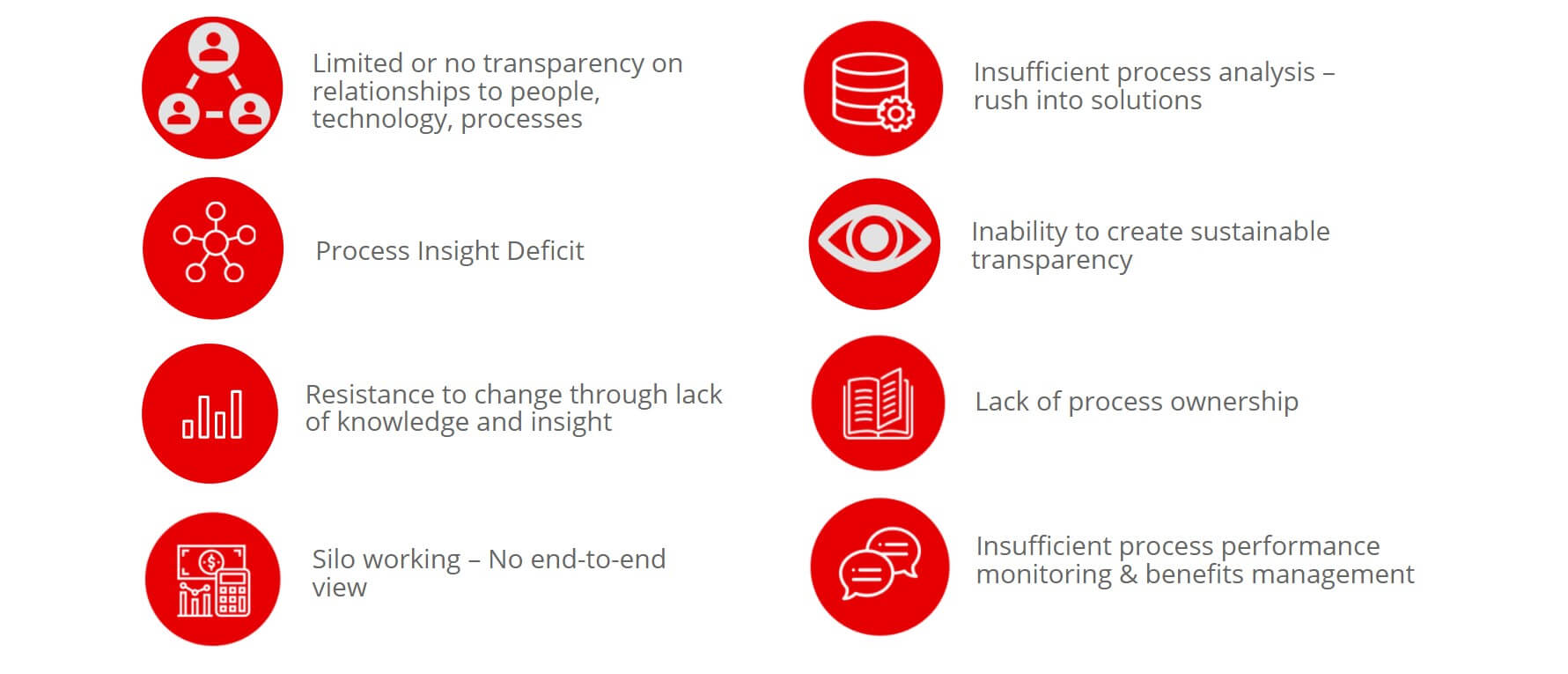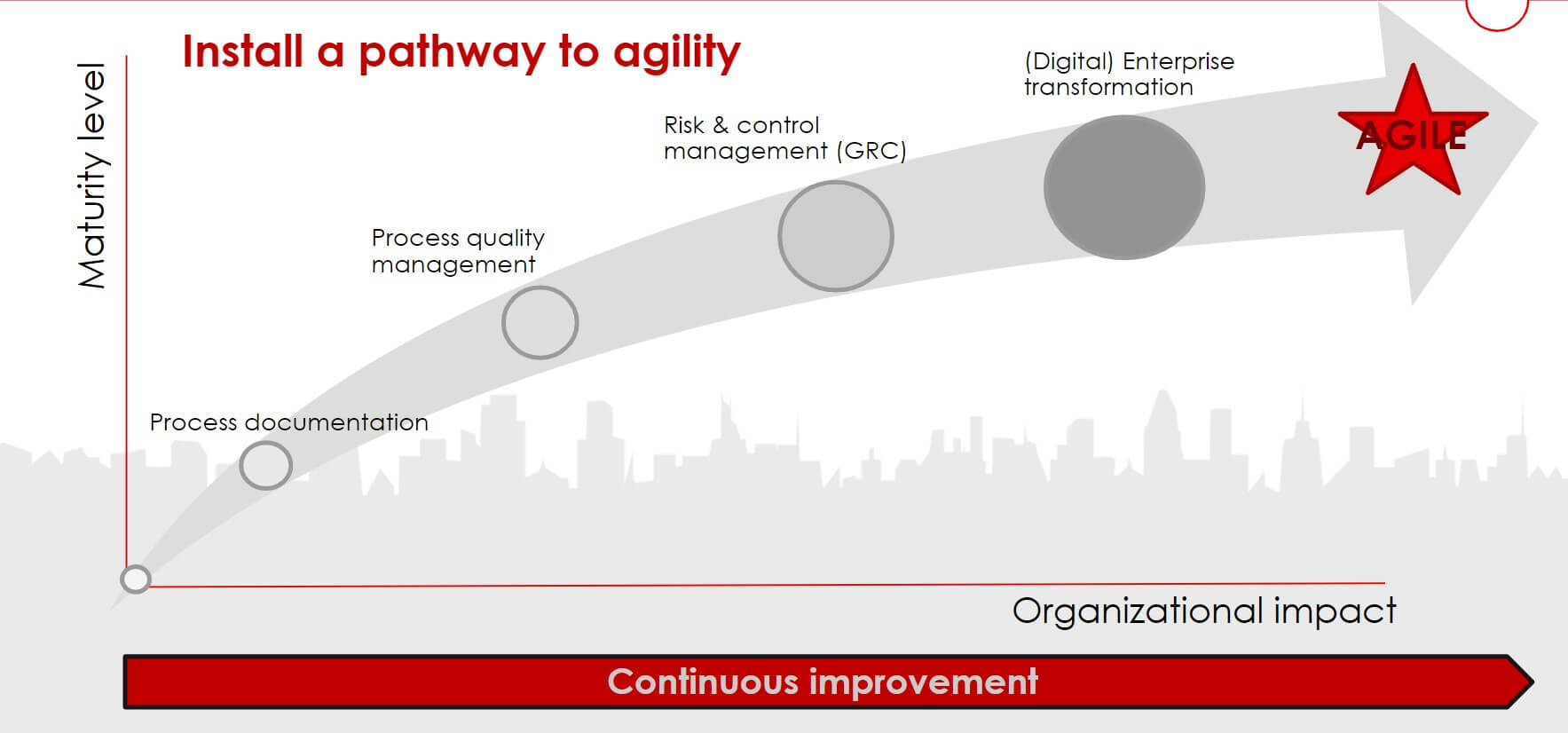- Move from individuals to organization-wide process thinking
- Create a continuous improvement mindset
- Raise your organization's business process maturity level
Covid-19 makes transferring knowledge, getting connected end-to-end and transformation more relevant than ever before. Transformation is best initiated by bringing transparency to your processes and to the connections between processes, technology and people. Process transparency will increase employee satisfaction and motivation and will subsequently lead to a culture of business excellence. Text edited by Ben Tuerlings and Dirk van Bastelaere
The post-normal
As the Covid-19 waves keep rolling over the planet, we do not know what the new normal will be. What we noticed, however, are movements in the market. Public sector companies going for full or partially remote working. Companies starting new digitization projects to sell (more) online than in their brick and mortar shops. These examples clearly show a need for process transparency.
During a Virtual Expert Session on Business Process Management, TriFinance experts shared insights into how to create sustainability in processes and install a continuous improvement mindset in your organization.
The session was hosted by CFO Services Client Partner Maddy Lauwers and Project Manager Brigitte Dulak. Participants from various industries, such as Flooring, Banking, Airport services,... contributed by sharing their experiences and challenges.
Lowering barriers and creating visible and transparent end-to-end processes will result in people better noticing their contribution and becoming more dedicated
Maddy Lauwers, Client Partner CFO Services
Veering towards continuous improvement
Collaboration will be part of the new game. Lowering barriers and creating visible and transparent end-to-end processes will result in people better noticing their contribution and becoming more dedicated. In fact, change is happening there.
Usually, ad hoc process analysis and improvements are triggered by new regulations, SOX compliance, a new ERP implementation or other internal or external impulses. In these cases, every new project requires new process updates, which is a significant investment and creates frustration. An organization can’t afford this every two years.
To visualize all business processes, a sustainable effort is initially required. A circle needs to be created that can be transformed into a continuous improvement mode.
Scrutinizing documentation
When starting a project at clients, we are often informed that processes are documented and kept up-to-date. Looking into that documentation, we usually make the following findings:
- There is limited or no transparency in relationships between people, technology and processes, i.e. who is part of the process; what are the roles and responsibilities; which tools are used, which processes are linked and around.
- There is a clear process insight deficit. Not all actors within a process capture all the required insights.
- There is resistance to change by lack of process transparency, knowledge and insight.
- Because there is no end-to-end view, people work in silos. The more insights and visibility around processes are created, the easier it will be to cultivate process participation within a functional domain (silo), across functional domains or even on an organisational end-to-end level. In the majority of cases, the organization is not built around the end-to-end process.
- People rush to solutions because of insufficient process analysis. Businesses feel the pressure to change more quickly and frequently which leads to quick process fixes without first making a root cause analysis.
- The organization is unable to create sustainable transparency. If processes in an organization are not ‘alive’, people don’t feel the need to keep them updated or transparent. Every time a new project is initiated, the same train of activities (interviews, documentation) starts all over again.
- There is a clear lack of process ownership. In many cases, process ownership is only established within the functional domains and not end to end.
- There is insufficient process performance monitoring and benefits management. Appropriate KPIs that drive behavior will result in what the organization wants to achieve: living processes.
Implementing a process management culture will generate numerous benefits in the regular business and when initiating new projects.

The pathway to agility
Current trends show that we are in a globalized and interconnected world where movements and interchanges happen at an increasingly faster pace. The pandemic will additionally drive these forces. We are interconnected, but anytime we analyze business processes at organizations, it seems that there is little end-to-end interconnection.
Different business developments like Shared Service Centers, Offshoring or outsourcing, however, drive the need for more visibility, making C-levels slowly but surely recognize the need to have processes and the different relationships that are linked to them made transparent.
A lot of companies also talk about value streams and customer journeys where processes are involved. These will only come alive and run in a continuous improvement mode when organizations see the power of good end-to-end processes.
Process mining software can help you make understand your processes and achieve insight into the ways your processes really run, but unfortunately process mining alone won’t be the solution. During a process discovery phase, business insights will be created and the connections between people, technology and processes become apparent. Based on this, the vision can be shared and the goals can be aligned.
Having these insights supported by the appropriate technology, the company is able to move towards a continuous improvement mindset or an agile organization. We have experienced that by creating transparency at the start of a transformation, the business will recognize the benefits and is motivated to go along. People going through transformations will be impacted. They have to be respected as a person and their input should be valued. This will result in a roll-forward of new ideas. The business will be in control and not be controlled by others.
The road to sustainable transformation
Transparency of business processes makes actors understand the way of working, guaranteeing compliance and business continuity. Transparent business processes are also fundamental to transformation. It all starts with properly documented and managed business processes, identifying risks and controls related to or arising from the organization business processes that generate sustainable transparency on relationships between people, technology, processes. And all this will finally trigger a workable transformation which is actually what the company is trying to achieve.
This road to sustainable transformation and organizational agility is not just a method. It is a pathway that involves process transparency and that covers stages of an organization's process maturity. This evolution to organizational agility is not about becoming agile as an individual or as a team, it is about an organization-wide continuous improvement mindset.
To raise your organization's process maturity level, you have to move toward an organization-wide process mindset that offers collective creativity, participation and involvement in processes
Brigitte Dulak, Project Manager CFO Services
Applying the TriFinance Process Maturity Model
The TriFinance Process Maturity Model illustrates the possible levels of maturity at which processes are mastered and managed. Organizations mature from undefined or individualistic to agile through a number of transitional phases, ie. from cross-silo to organization-wide end-to-end.
In a broad survey on Business Process maturity that TriFinance has conducted, we distinguished five components to measure the level of process maturity: strategic alignment, governance, culture, people, and methods, not mentioned in order of importance here.
- Strategic process alignment focuses on top-level engagement and implicates a process improvement mindset.
- Process governance concentrates on taking ownership of processes. The organization embeds and governs a process management practice, where people take ownership in processes and in process management roles.
- A process-oriented culture will cultivate awareness and support employee engagement on performance of process management and processes as such.
- ‘People’ aims at communication and above all end-to-end collaboration outside of the typical silos.
- Methods spotlight the tools and techniques for process management and their constructive use.
The survey revealed that roughly 80 percent of participating organizations are situated in level one or two, which is ‘undefined’ or ‘defined’. The model enables organizations to evaluate their process maturity level and develop a pathway to agility.

At the heart of a unique transformation journey
Within BPM, a wide variety of things are happening. In the first place, the end-to-end processes (cross-functional and business) need to be made transparent. This is the discovery and documentation angle. When the organization starts optimizing, designing and redesigning processes for better performance and profitability, functional expertise in different domains and technology expertise is required. This will assist the organization to raise the level of process maturity step by step. All this is a significant investment for a company.
The transformation needs to pay off by creating a sustainable process environment. This entire effort can’t be performed every two years. The process management approach needs to be in a continuous improvement mode since it never reaches a final state. The entire organization needs to be taken along with this. During projects, we have experienced many times how organizations can change towards this new environment and are often surprised about how new dynamics arise and what experts in the different steps of a process can bring together. This also impacts the pace and the scale of the change positively. In this way, organizations don’t need new top-down projects every time.
Enablers of Business Process Management
In order to manage your processes, you need to discover them and be able to chart all related topics, the different stakeholders, the variety of applications and tools, applied legislation, internal and external compliance rules, and so on.
Two approaches are possible:
- Start your discovery through the people involved by conducting interviews and organizing workshops. In a second step, technology is used to test the process consistency. Finally, this output should be reflected back to the team.
- Set up a process mining tool and discover the process as it flows through the applications and systems, then try it out with the people involved. In a second phase, the outcome is discussed with the relevant actors.
In both approaches, it’s the people who will make processes, their input, output, and runnings visible within the organization.
You need more than just a designed process to bring organization-wide transparency, enable transformation, keep processes alive and make sure that everyone is involved in rethinking, improving and developing business processes. You need an enabler and process management to keep processes alive.
Related content
-
Reference case
How Data kickstarted a transformation at a leading financial institution
-
Reference case
Helping a major bank turn complexity into structure: Olivier Renard on his digitalisation mission
-
Blog
Final Call: E-invoicing
-
Article
The CFO as the conductor of change management in (Finance) Transformations
-
Reference case
Setting the standard for CSRD at a leading European retailer
-
Article
Beyond complexity: Driving sustainable change at a large Belgian insurer with TriFinance